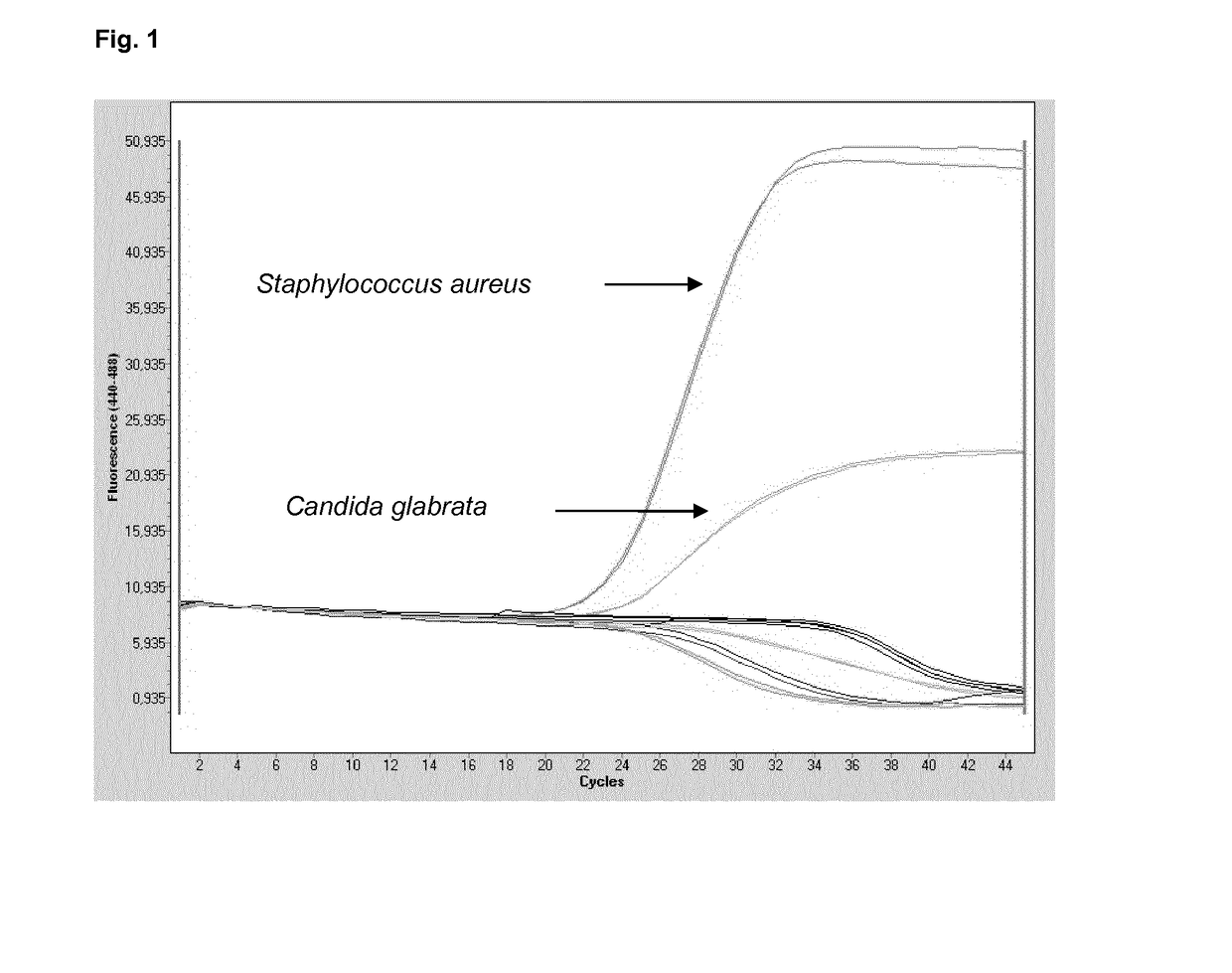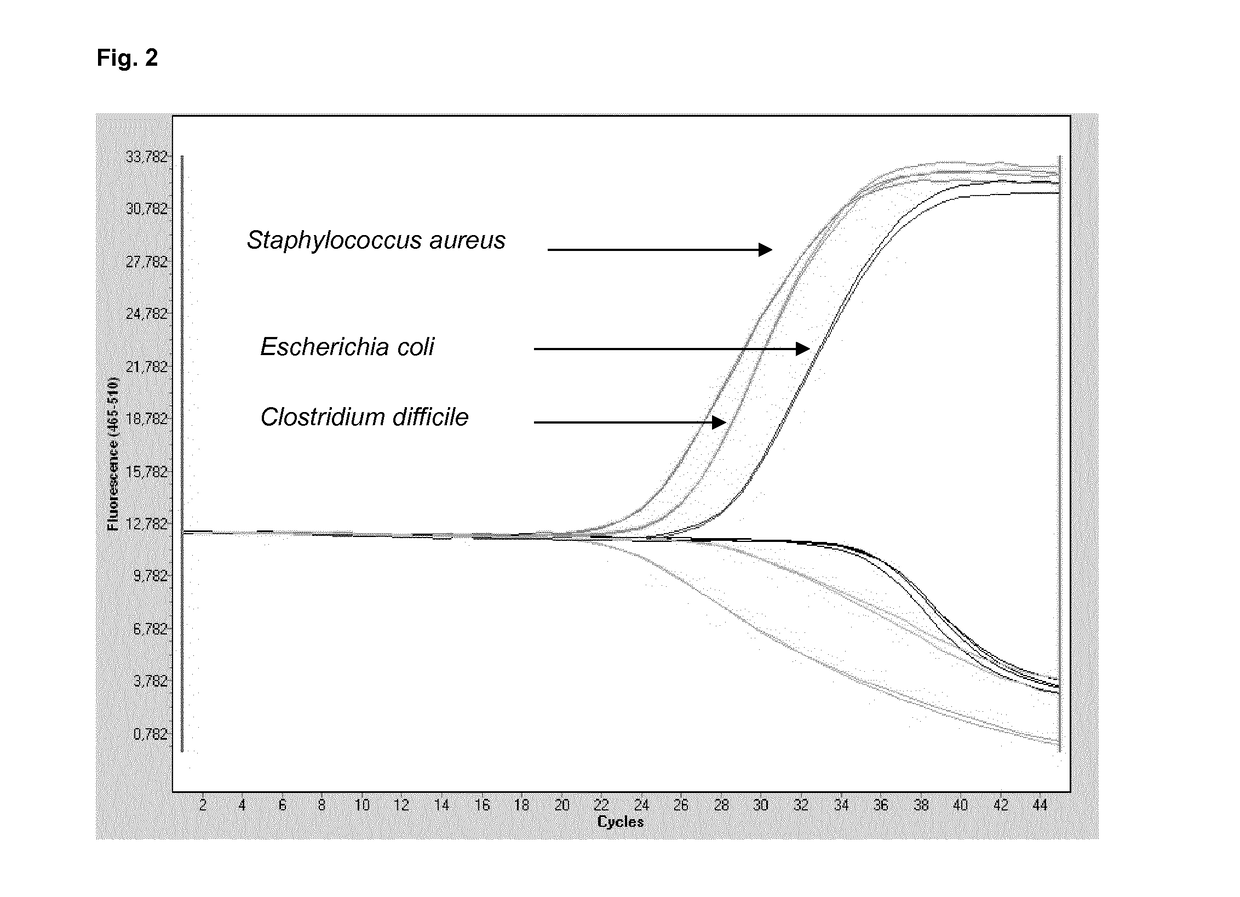Method for the detection of sepsis
a sepsis and detection method technology, applied in the field of sepsis detection, can solve the problems of 60,000 cases of sepsis per year, diagnosis is often only provided the diagnosis is often too late for effective treatment, so as to achieve the effect of simple execution
- Summary
- Abstract
- Description
- Claims
- Application Information
AI Technical Summary
Benefits of technology
Problems solved by technology
Method used
Image
Examples
example 1
[0185]The multiplex approach according to Table 3 was applied to demonstrate the combined sensitivity of the present multiplex reaction, in addition to the stringency with respect to the absence of false-positive results.
[0186]A mixture of the five species of pathogens was provided in a test sample at the dilutions provided. Multiplex PCR was carried out using two primer pairs according to SEQ ID No. 1 and 2 (for 16S targets) and SEQ ID No. 9 and 10 (for 18S targets).
[0187]The probes according to SEQ ID No. 8 or 12, directed to staphylococcus and candida detection, respectively, tested in combination and separately, were coupled to the 440-488 / Atto425 label.
[0188]The probe according to SEQ ID No. 3, directed to any given bacterial target, was coupled to the 465-510 / FAM label.
[0189]The probes according to SEQ ID No. 4, 5, 6 and 7, directed to gram positive bacteria, tested in combination and separately, were coupled to the 533-580 / VIC label.
[0190]The probes according to SEQ ID No. 11...
example 2
[0201]This approach described in example 1 was carried out for a number of pathogens in order to demonstrate the broad spectrum of microbes capable of detection by the present method.
TABLE 5List of microbes analyzed and results with respect to amplification.440488 / 465510 / 533580 / 618660 / SpeciesAtto425FAMVICCy5ResultsAcinetobacter baumannii−+−−Gram − BacteriaArcobacter butzleri−+−−Gram − BacteriaAeromonas caviae−+−−Gram − BacteriaAeromonas hydrophila−+−−Gram − BacteriaAreomonas sobria−+−−Gram − BacteriaAggregatibacter−+−−Gram − BacteriaAggregatibacter aphrophilus−+−−Gram − BacteriaAlcaligenes faecalis−+−−Gram − BacteriaBordetella bronchiseptica−+−−Gram − BacteriaBordetella parapertussis−+−−Gram − BacteriaBordetella pertussis−+−−Gram − BacteriaBurkholderia cepacia−+−−Gram − BacteriaCampylobacter jejuni−+−−Gram − BacteriaCampylobacter coli−+−−Gram − BacteriaCampylobacter fetus−+−−Gram − Bacteriassp. FetusCampylobacter rectus−+−−Gram − BacteriaCampylobacter upsaliensis−+−−Gram − BacteriaC...
PUM
| Property | Measurement | Unit |
|---|---|---|
| Fraction | aaaaa | aaaaa |
| Fraction | aaaaa | aaaaa |
| Fraction | aaaaa | aaaaa |
Abstract
Description
Claims
Application Information
 Login to View More
Login to View More - R&D
- Intellectual Property
- Life Sciences
- Materials
- Tech Scout
- Unparalleled Data Quality
- Higher Quality Content
- 60% Fewer Hallucinations
Browse by: Latest US Patents, China's latest patents, Technical Efficacy Thesaurus, Application Domain, Technology Topic, Popular Technical Reports.
© 2025 PatSnap. All rights reserved.Legal|Privacy policy|Modern Slavery Act Transparency Statement|Sitemap|About US| Contact US: help@patsnap.com



